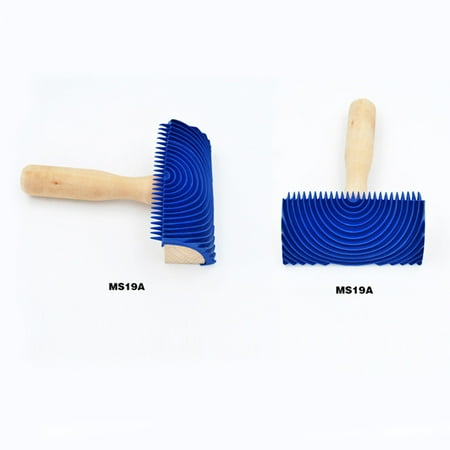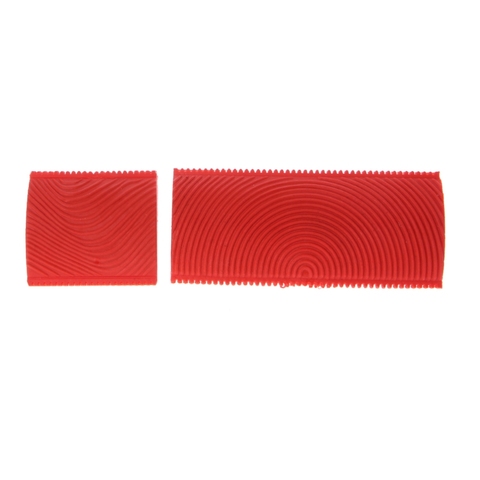- Spray Paint Wood Grain Look
- Painting A Wood Grain
- Wood Grain Paint Roller Or Brush
- Wood Grain Paint Rollers
Graining—the imitation of wood with paint and glaze—was an early American skill cloaked in secrecy. Expert grainers, who were protective of their techniques, could paint a facsimile of expensive hardwood that was indistinguishable from the real McCoy, giving trim, wainscot, or doors of cheap softwood the appearance of a higher-end material. Today, it’s possible to reproduce graining with a little know-how and practice.
Before You Start
Decide the species of wood you want to imitate. Vertical-grain oak, walnut, or mahogany are fairly simple and can be done with common tools, while imitations of quarter-sawn oak, bird’s-eye maple, or crotch mahogany are more difficult. It’s a good idea to begin on a sample board to see if your glaze is the appropriate color and consistency, and to hone your technique.
Tools & Supplies
Q: How to paint a wall to look like wood grain? You can paint a wall to look like wood–it just takes time and patience. Tape off the wall in a wood pattern with mini grout line tape. Paint your walls a solid color. Pull off the tape to reveal the spaces between the wood. Next, using a wood graining tool, add grain to the “faux planks” on. The easy to clean smooth wood-grain laminate material is incredibly lightweight and sturdy. The Mezzo allows you to focus on the paints and brushes you are using by making them more visible. You could even use multiple sets to display and organize a larger collection of paints and brushes. The configuration possibilities are endless. How to get a wood grain effect over chalk paint. Using Minwax Pro Series Wiping Wax in Dark Roast and a wood grain tool.This technique can be used on furnitu.
- Thinned low-sheen enamel in a light color for the base coat (recommendations: Benjamin Moore’s Richmond Gold for oak, Maryville Brown for walnut, and Burnt Caramel for mahogany)
- Glaze, such as oil-based, heavy-bodied ZAR (Tip: Choose the color at the paint counter by smearing finger dabs over the base color paint chip.)
- Satin varnish or polyurethane
- Sandpaper—either 220-grit or 320-grit wet-and-dry
- 2″ or 2½” trim brush
- Steel graining combs (optional)
- Clean cotton T-shirt rags (for use with steel combs)
- Flogger brush (or any cheap brush with long, floppy bristles)
Step 1

Apply the base coat as smoothly as possible, brushing it in the direction of the wood grain to diminish brush marks. Two coats are better than one, and thinning the paint helps (use mineral spirits for oil paint, water or Floetrol for latex). Once dry, sand oil-based paint with 220-grit sandpaper, and latex with 320-grit wet-or-dry paper and a little water. Clean the surface with a damp cloth or tack rag.
Step 2
Brush the glaze evenly over the surface and then out into long, even striations. The glaze is a semi-transparent coating (neither paint nor stain) used to imitate the wood grain. The base coat shows through it, and the grain formed with the glaze “stays put.” For a simple grain pattern, lay the brush over the glaze and press the bristles down with three or four fingers as you pull the brush through the glaze. You can alternate the pattern by wiggling the bristles.

Step 3
For another simple technique, wrap a piece of cotton rag tightly around the end of a steel comb and pull it across the glaze. Always move at an angle to avoid perfectly straight patterns. Next, add pores by tapping the large flat side of the flogger brush at an angle across the surface.
Step 4
Once the glaze has completely dried, apply the varnish coat with the grain of the wood. To avoid holidays (skipped areas), work under a light and from a raking angle. Or cross-brush the surface: First apply the varnish at a right angle to the grain, then smooth it out in the other direction. One coat of varnish is usually enough protection. (Use two coats on areas of hard wear.)
Take wood furniture from drab to fab with a fresh coat of paint.
Photo: The Frugal Girl
Most anything can be transformed with a can of paint and some step-by-step instructions. Here’s an easy, four-step tutorial on how to paint wood furniture:
STEP 1: Sanding
The first order of business when painting wood furniture is sanding. Don’t be tempted to skip this step. Proper sanding will ensure an even, smooth finish that is not prone to chipping. I use an orbital sander, but other finishing sanders would work just fine too.

(I wouldn’t really recommend hand-sanding unless you are very strong and very patient. It takes a LOT of sanding to remove old paint and stain, and I would get very weary of sanding if I had to do it manually. I get tired of sanding even with the orbital sander!)
I usually start out using 80- or 100-grit sandpaper, especially if there’s a durable lacquer finish on the piece.
Once most of the stain/paint has been removed, I switch to 150-grit or higher to remove any remaining finish and smooth out the surface.
Once I’ve sanded everywhere I can with the orbital sander, I tackle hard-to-reach spots by hand with either a sanding block or a piece of plain sandpaper that I can bend and fold to reach awkward areas. As long as you sand enough to remove the sheen, the primer and paint should stick.
STEP 2: Dust Removal
When you’ve finished sanding, it’s important to remove all the dust, as residual dust will not only mess up the new finish, but also keep the paint and primer from sticking. I often use a damp cloth, or sometimes a dry cloth followed by a thorough vacuuming.
Now comes the fun part! (I hate the prepping.)
STEP 3: Priming
Once your piece is sanded and dust-free, you’re going to need to prime it. I prefer to use a spray primer, as it usually gives a neater, thinner coat than a brush-on. Obviously, gray is best to use under dark paint colors, and white is best for light colors.
When you prime, you want to do several very thin coats. In fact, when you do the first coat, it should barely look like you’ve even primed. Let the primer dry for ten minutes or so (depending on the weather and manufacturer recommendations), then do another coat. Let that coat dry before doing one or two more. The goal is to have the piece completely covered in a thin, even coat of primer.
Depending on the wood type, I sometimes sand before the last coat of primer goes on, as the primer can raise the grain of the wood. If the surface doesn’t feel smooth to the touch, I run the orbital sander lightly across, using fine-grit sandpaper. I wipe it down again, apply one more coat of primer, and I’m finally ready to paint.
STEP 4: Painting
My favorite paint for wood furniture is Rust-Oleum Painter’s Touch Semi-Gloss (view on Amazon). This paint is thinner than ordinary paint, which makes it easier to achieve a smooth finish. Painter’s Touch comes in several different sheens, but I like to use the semi-gloss. (One can goes incredibly far. Just to give you an idea, the 2-1/4 cans I’ve used so far have covered two dressers, three nightstands, a chair, a desk and a file cabinet.)
Mix the paint well and using a clean paint brush (I use a regular, bristled brush, not a foam brush), brush on a very thin first coat.
Just as with the primer, it’s very important to do a number of thin coats. I don’t think I can overstress this: applying five thin coats is much, much better than one thick coat. The thin coats look better, and they will be more durable.
I have also found that when you’re painting a large, flat section (like the top of a dresser), it’s best to use long strokes that cover the entire length of the piece. This will help to ensure a smooth finish with an even gloss.
Spray Paint Wood Grain Look
This paint dries very quickly, so by the time you’ve put a coat of paint on the entire piece of furniture (unless you’re painting in very humid conditions), the area you first painted should be dry again. If it’s not, wait ten minutes or so, then apply another very thin coat. Repeat this process until the furniture is painted to your satisfaction.

Painting A Wood Grain
If you sand down to the wood, are careful to apply thin coats of paint, and your piece of furniture is made of nice wood, then you should be able to turn out a smooth, durable finish while still being able to see some wood grain through the paint.
And if you’re anything like me, once you see what an enormous difference paint can make, you’ll start looking around for more stuff to paint.
Wood Grain Paint Roller Or Brush
Happy painting!
Wood Grain Paint Rollers
When she’s not homeschooling her four children, Kristen is making a name for herself on the web as The Frugal Girl, a blog dedicated to DIYs, repurposing projects, and living simply. Kristen is enthusiastic about living on less—a passion that has allowed her to use her creativity to its fullest. We can’t wait to see what she does next!
